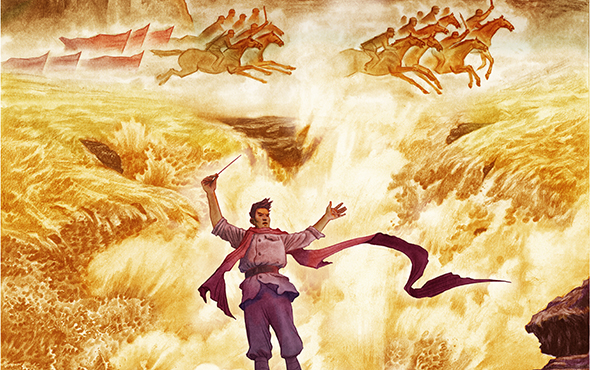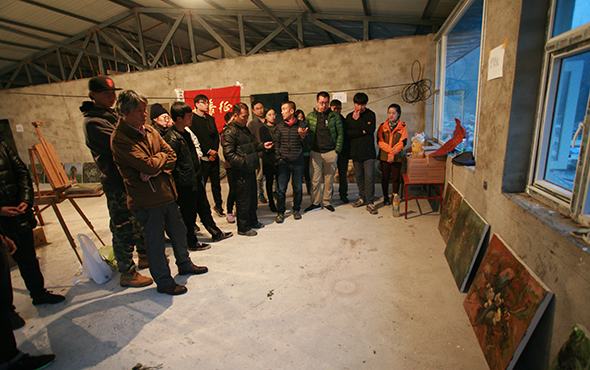
Tang Hui, Ode to the Yellow River, 2016; Mural Painting, mosaic painting, 200×200cm
My work is located in the new city of Yan’an, the planning of the new city takes the urban cultural construction into account, Yan’an University, Yan’an Opera House and the art museum and museum is in the process of planning and will be also located in the new district. It also reflects the direction of the Chinese socialist mainstream cultural construction. The whole mural painting uses an expressive method in mosaic, to reflect the mother river that represents the Chinese soul – Ode to the Yellow River, hopes to convey our indomitable spirit to the Chinese nation. The subject of the screen is the Hukou Waterfall, this represents the power of the Yellow River that starts with a calm source, spouts when it flows through Hukou, then bursts out with amazing power. This force represents the cultural accumulation of the Chinese nation over thousands of years, and the turn in the critical historical point of the Long March, while the Hukou Waterfall-like spirit of the nation collectively bursting out.
Bai Xiaogang: Sketch Transforms Feelings of the Scene to the CanvasAs everyone’s creative ideas and directions are different, people should choose the place which is suitable for them to start a creation. For example, Li Yang, a teacher of our department, combines the characteristics of mural materials and went to Zibo in Shandong to fire a group of ceramic works themed on the Long March; Tang Hui created a large-scale mural painting entitled the “Ode to the Yellow River” in Yan’an; teacher Cao Wei and me went to Guizhou Province, starting from Zunyi, to sketch on site along the road of the North of Guizhou, experiencing the significance of the Long March in the process of “going again the way of the Long March”. Sketching is not a fiction based on pictures or information, but transforms feelings of the scene to the canvas, which is also called “going deeper into the historical scene” as stressed by President of CAFA Fan Di’an at the meeting. After returning from the scene, we will use these works as material to discover the creative direction, to have an in-depth discussion on the theme and expand it, ultimately form a series of works.

Teaching Course of the Fundmental Department of the School of Plastic Arts at CAFA at night
The spirit and ideological level of the older generation of artists was very high, compared with them, our generation is somewhat dispirited. Although we have a wealth of material goods to improve our living conditions, we are not as strong and powerful on a spiritual level. Therefore, for the interpretation of the classic works, we should not only see their artistic language going beyond the times but also understand the ideological realm and artistic feelings behind their creation.
Secondly, seen from the perspective of cultural transformation, our generation is in a transformational stage of industrial civilization that is transiting towards apost-industrial civilization. As President Fan Di’an has repeatedly stressed: “Allow the traditional language to enter the contemporary context”, in this period, how to adapt through an in-depth thought process and diverse forms to balance the relationship between traditional and contemporary is our generation’screative purpose. Therefore, it is necessary for our creative team to find the spirit of the footprint of our predecessors and to think of the contemporary creative advantages. It is summed up in the words “Reviewing the Old”.

Qiu Zhijie, Tablet-Name, 2016; Photography, which can be exhibited as video installation, dimension adjustable
First of all, I want to say that Experimental Art is as a young discipline in the family of art, its involvement in the project of major historical themes also requires our continuous effort and is a test of time. But I am glad to see that the teachers and students of the School of Experimental Art have a tradition of caring for society and a focus on the performance of social and historical themes. Secondly, the teachers and students of the School of Experimental Art pay more attention to the transformation of folk culture in the creative activities of “Long March of Art”. Teacher Lv Shengzhong often spends a lot of time and energy transforming the traditional cultural resources into contemporary art, just as mobilizing the masses on the road of the Long March. In particular, the combination of the universal principles of Marxism and Chinese practice has a unique embodiment in the education system of Lv Shengzhong. Our creative mechanism is different from other schools. The School of Experiment Art organizes teachers and students to go to the countryside every year to interview people instead of sketching. In our education system, we have folk-oriented, social-oriented characteristics, and have an interest in folk culture. We more focus on starting from the perspective of the history and culture to place the Long March in a period of Chinese history of modernization, using the context of Chinese modernity to interpret it. I have proposed the use of “project leading teaching, project leading creation”, each teaching project is actually an exhibition, it is the production process of an exhibition, which includes the creation of exhibited works. Creative process and teaching objectives are closely combined and it’s necessary to allow the new mechanism to become the norm.

Liu Xiao, Everyone's 'Long March', 2016; Sculpture, 90×50×50cm. Brooch 5×10cm
The exhibition space and design is not an independent action, and it is often associated with the curating itself. Seen from the curatorial perspective, I have to take the expected image of the exhibition and space effects into account, and we need to closely integrate them into the work. The curating itself is a work and a space design is also a work. Therefore, although my subject identity is responsible for the display design of the image space, I have to take the height, depth and breadth of the planning into account, and they must be consistent with the exhibition theme of the “Long March of Art”. Throughout the planning process, I consider all things from an overall perspective, instead of the design of a single direction. According to the curatorial theme, the story of the Long March is divided into four parts. They respectively occupy part of the exhibition space in my mind, and first of all, it reflects the academic and teaching status of the Central Academy of Fine Arts, secondly, it has an holistic planning that depends on the degree of participation of each faculty. While considering the differences in various professions, I based my ideas on the perspective of the disciplinary organization and the new creative mechanism, to create a comprehensive and diversified exhibition that can reflect the innovative mechanism. It reveals an exhibition form that is completely different from the previous similar thematic exhibitions.
Translated by Chen Peihua and edited by Sue/CAFA ART INFO




























